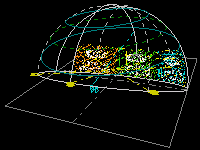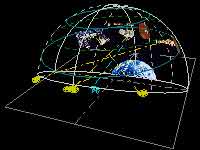| In the production studio: Computer with CD-ROM drive Image processing software Output device |
| In the theater 1. At least three dissolve-pair slide projectors in L-C-R array |
| 2. Dissolving horizon panorama and/or all-sky projector system |
| 3. Planetarium star projector |
| Recommended: Zoom-slew Rotator |
| NOT used: Video |
Larry Cat In Space Equipment Requirements
With more than 160 images to show, Larry Cat In Space can be a challenging show to program; it requires a moderately well-equipped planetarium theater to present. We've provided this page to help you determine if your planetarium has the necessary equipment to present Larry Cat In Space.
The show soundtrack is recorded on CD, so you'll need a CD player to play the disc, even if it's just to copy the audio to another medium, such as multi-track tape or hard drive.
The show's still images are recorded on data CD, so you'll need the resources (computer, image processing software, output devices) to transform the digital images into whatever form your theater uses to project. For classic (slide-projector-based) planetaria, that will mean making 35mm slides.
1. At least three dissolve-pair slide projectors in Left-Center-Right array
This is a screen format familiar to long-time Loch Ness Productions customers.
Many of the scenes in our shows are illustrated with three images, which are introduced in sequential order: Left, then Center, then Right. After all three are up, they often "wipe" off in the same order.
In this show, the left and right screens don't necessarily have to be dissolvers, but for timing, there are instances in which dissolve pairs may come in handy.
We say "at least three" dissolve screens, but the more, the merrier. There are several points in the show where you may wish to make a whole-dome montage of images, such as the Moon snapshots.
2. Horizon panorama and/or all-sky projector system
There are at least 6 multi-panel images in the show — which, using 20th-century terms, can be translated as horizon panoramas. In the digital age, what may be a 3-panel pan in one theater may be a 2- or 4-panel pan in another, or a pan can be remapped to an all-sky. Nonetheless, you'll need that calibrated set of projectors which project on the horizon, commonly known as a panorama system.
As you know, individual slide frames are in a 3:2 ratio. Many of the multi-panel images double and triple that width, abutting the single frame images into a 6:2 or 9:2 format ratio — what might otherwise be called "2- and 3-panel partial pans". These are intended to span approximately 60 to 90 degrees on the horizon.
As you page through the images, you'll notice many objects have an obvious bottom — people standing, houses based firmly on the ground, etc. — which would look rather silly floating in the sky. Therefore, it's important they be projected on the horizon, at the base of the dome.
3. Planetarium star projector
Larry Cat In Space uses the planetarium star projector only for its starfield, when depicting space scenes. When we're not depicting space scenes — which is most of the time, actually — we recommend fading stars out. The starfield shouldn't be generic wallpaper throughout the show.
Recommended: Zoom-slew, Rotator
While non-moving slides can illustrate the scenes, the show will benefit from having, for example, the van zooming away, the space plane slewing to the space station, etc.
When Larry is weightless, he tries to catch his tail; image #95 is designed for use in a rotating-image projector.
NOT used: Video
We use no moving video with the show, intentionally. This is a program designed for the pacing of still imagery. The visual style of the show is non-dynamic slides. To have inserted just one or two video clips would have been very jarring and out-of-context with the remainder of the show. In other words, why would there be only one or two scenes that feature full motion animation, when the rest of the show doesn't have any?







